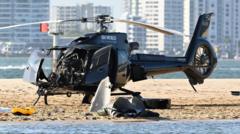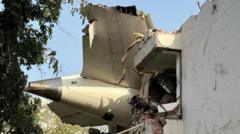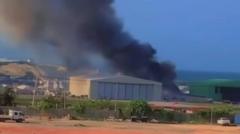A recent investigation by Australia's Transport and Safety Bureau (ATSB) highlights failures in air traffic management, contributing to a helicopter crash that claimed four lives, including two British tourists.
Faulty Antenna Linked to Tragic Helicopter Collision in Australia

Faulty Antenna Linked to Tragic Helicopter Collision in Australia
Investigation reveals serious safety oversights in theme park helicopter accident that resulted in four fatalities.
A catastrophic mid-air collision of two helicopters at Australia's Sea World theme park underscores the dire consequences of safety oversight in aviation operations. The incident, which occurred in January 2023, resulted in the deaths of four individuals, including newlyweds Diane and Ron Hughes, who were on holiday. An investigation by Australia’s Transport and Safety Bureau (ATSB) found that a faulty radio antenna contributed to the accident, preventing vital communication between pilots.
The crash occurred just moments after one helicopter took off while the other was landing, designating a case of miscommunication compounded by a lack of effective risk controls that had evolved over time at the Sea World resort. According to the ATSB report, the changes at Sea World - such as the introduction of a second helipad and larger helicopters - were designed to enhance operational capacity but ultimately reduced safety margins.
In the critical moments leading to the tragedy, the pilot of the helicopter preparing for take-off did not receive a crucial taxiing call from the landing aircraft, likely due to the faulty antenna. This failure meant that essential coordination between the two choppers was compromised, and by the time the take-off helicopter was airborne, it entered the same airspace as the landing helicopter without situational awareness of the imminent risk.
The ATSB report also emphasized that the pilot of the inbound helicopter had visual contact with the departing aircraft but had not been warned of the impending collision. A ground crew member mistakenly informed the departing helicopter's pilot that the airspace was clear, further complicating the safety narrative.
The crash has triggered a series of introspections and has led the ATSB to recommend that aviation operators carefully manage any operational changes with an eye toward comprehensive safety procedures. Angus Mitchell, Chief Commissioner of the ATSB, noted, "Changes that aim at enhancing safety can often lead to unintended consequences; hence, every modification must be carefully managed."
While six passengers aboard the helicopter that landed experienced serious injuries, many have expressed appreciation for their pilot's heroic actions that saved additional lives during the emergency landing. This incident serves as a critical reminder of the paramount importance of stringent safety protocols and clear communication in aviation.





















